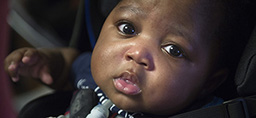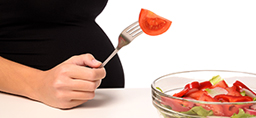
The two lines on the home pregnancy test confirmed it: You’re pregnant.
So many things to think about.
And one word that is bound to hit you at some point is exercise—or lack thereof.
Spectrum Health obstetrics and gynecology practitioner, Sarah Strong, DO, noted that the news of pregnancy often triggers a sudden desire to start exercising.
“Especially for first-time moms, there is stress over the unknown component of what to expect regarding weight gain during pregnancy,” she said. “For women already overweight, even more anxiety can result—‘How can I keep this in check?’”
Beginning to exercise from ground zero is not ideal—your body will go through a lot of change as it is, without going crazy on fitness out of the blue.
That said, Dr. Strong advised that it’s always the right time to take care of your body. Done right, whether seasoned workout buffs or newbies, you can be physically fit and pregnant at the same time.
As a mother who exercised through two pregnancies, Jessica Corwin agrees.
Corwin is a registered dietitian nutritionist and also an educator for the Good Start For You and Your Baby class offered by Spectrum Health Healthier Communities. The free class sets out to educate new moms on how to live well and eat right during pregnancy.
Corwin grew up in an active family and has always enjoyed team sports and outdoor recreation. Of her first pregnancy with son, Cruze, she said, “As soon as I found out I was pregnant, even with morning sickness, I started researching prenatal exercise. I remember wondering, what exactly can I do? I was a runner, a walker, a hiker. I also enjoyed pilates, yoga and strength training, but I wanted to make sure I did what was best for my baby.”
For Corwin and other already-active moms-to-be, the road would be easy to navigate. But for many women, busy lives haven’t always left time for regular workouts. And what about those who are carrying extra weight (or trying to lose it), when they learn they are pregnant?
Dr. Strong reassures these moms-to-be.
Getting started with exercise
“The key is to talk to your doctor honestly about where you are at the beginning, and about what you’d like to achieve during this pregnancy,” she said. “Do you hope to prepare your body for labor? Do you wonder if it’s OK to continue your weight-loss efforts if you’re overweight now? Is your goal to maintain a level of fitness you’ve worked hard to achieve?”
Many options are open, when done safely. Because each pregnancy is unique, this is a great conversation to have with your doctor.
For Corwin, having some privacy was important.
“I was feeling sick, I was growing and (at home) I could do as much or as little as I wanted without feeling awkward or embarrassed,” she said. “I got some prenatal exercise DVDs and loved them. This was also a convenient option for me with my busy workdays. But the camaraderie and social aspect of group classes with other expectant moms was also appealing.”
Need to Know
Exercise risk factors in pregnancy
- Placenta previa
- Preterm labor
- Water breaks early
- Lung conditions
- Carrying multiple babies
- Cervical insufficiency
- High blood pressure
What to avoid for all moms-to-be
- Road and mountain biking, rock walls and challenging hiking
- Contact sports with risk of impact or falls (first trimester might be OK)
- Exercise/activities in high altitudes, unless you already live there
- Hot tubs and hot yoga, which can increase body temperature unsafely
- Vigorous workouts longer than 45 minutes may affect glucose metabolism
- Aggressive yoga. Flexibility is good, but tendons and joints loosen.
- Racket sports present risks that may outweigh benefits
- Never do any diving or scuba diving during pregnancy
Corwin appreciated learning about different recommendations for strength, cardio and flexibility based on each expectant mother’s starting point, from newbies to lifelong exercisers.
“It gave me a sense of normalcy to see other moms working out,” she said. “For strength, I used light free weights and adjusted to how I felt. I started in my first trimester. Lots of workouts focused on legs. I also did strength training with my arms to prepare for carrying the car seat.”
How much and which exercises?
Can you run? Can you do abdominal work? Can you do yoga?
Dr. Strong assured us that if you’ve already been doing a routine, you’ll most likely be cleared to continue.
“Moderate exercise is good,” she said. “Moving large muscle groups in a rhythmic and continuous fashion keeps impact low and benefits high (think walking, elliptical, cycle, rowing).”
She added that a good rule of thumb for cardio exercise is that, if you can speak, you have plenty of oxygen going to your baby across the placenta. Dr. Strong also noted that spin classes offer biking enthusiasts a safer environment than going out on the road.
“Your center of gravity changes as you grow,” Dr. Strong said. “You don’t need a bike crash.”
Corwin, for one, noticed the change in her stability.
“I didn’t expect it, but I could really feel off-balance,” she recalled. “I chose workout shoes that would help me stay smooth and steady, especially in my third trimester. Athletic shoes designed for stability really can make a difference.”
Dr. Strong further advised, “Cardiovascular fitness and strength training work together for a good balance. Swimming is also a great choice. Especially as your pregnancy progresses, between the instability, loose tendons, growing belly—swimming eases muscle stress, you can’t fall, the water supports you and you get excellent cardio and strength benefits. You are unlikely to experience injury in the pool.”
She is also a fan of the over-sized exercise ball.
“Core strengthening is good and alignment exercises can ease back pain as the uterus comes forward,” Dr. Strong said. “Sitting on the ball helps increase trunk control. Strong abdominals help during delivery and recovery.”
During her second pregnancy, Corwin faithfully applied her core strength routine. She adjusted the details based on her trimester.
“As I got bigger, I used pillows underneath my back to keep myself from laying completely flat,” she said. “I used smaller moves during crunches—and I stretched a lot.”
Stay hydrated is key
Dr. Strong also advised that hydration becomes even more important during pregnancy. Without proper hydration, the effects of dehydration can be increased during pregnancy. It’s also important to take calories into consideration.
“Never skimp on your water bottle,” she said.
And even though you only need 200 to 300 calories a day extra during pregnancy, make them small, healthy additions of whatever wards off your morning sickness or will boost energy. This could include fruits, nuts, salad and lean protein.
Corwin laughed as she recalled her previously vegetarian diet.
“My husband was so confused,” she said. “Somehow, with my morning sickness, there I was craving meat—especially beef. But you will do anything to keep it at bay, so yes, I ate it.”
Conditions that call for caution
Are there times when exercise or activity should be restricted? Yes.
Dr. Strong explained that if you experience any complications or have risk factors that could trigger early labor or fetal stress, your doctor may have you cut back or stop. She urged women not to worry if this turns out to be you.
“We are talking about a few months of your life,” she said. “Your health and your baby’s are paramount, so taking a time out on a certain exercise to protect both of you will be well worth it.”
Most commonly, your doctor may restrict activity if you experience any spotting or bleeding early on. Up to 30 percent of pregnancies result in this symptom. If yours is one of them, Strong said, “You’ll most likely back off all activities just until we know it’s all OK. If two weeks goes by with no further bleeding, we can slowly and carefully get back to activity going forward. Your doctor will help you establish what’s safe.”
Preexisting conditions or risks and new developments or symptoms must also be considered.
“Obviously, if you experience any bleeding, shortness of breath, chest pain, contractions, or if you’re further along and your baby doesn’t seem as active in movement, we say stop and call the office,” Dr. Strong recommended. “If you have other risk factors, make sure they have been addressed.”
Take a breather once baby arrives
Dr. Strong shared that she recommends a complete hiatus from exercise for six weeks after your baby’s birth.
Not only has your body gone through a stunning task, you want to focus on bonding with your baby. You’ll also be running on very little sleep, which is more important than exercise at that time.
Dr. Strong explained that the uterus slowly goes back to normal during this time so your body’s recovery is your priority. For moms whose babies are born by C-section, make it eight weeks at least.
Additionally, Dr. Strong recommended no abdominal exercising until your doctor OKs it. This is especially true with C-sections as the muscles are pushed apart during delivery to reach the baby. They remain separated and need time to realign.
Corwin eagerly supports spreading awareness of holding off on abdominal work too soon, as she experienced this first-hand.
“This was a huge shock to me, especially after having Cruze who was my giant baby,” she said. “I experienced diastasis recti—the separation of the muscles. I was thankful to have had this brought to my attention. It was also a great help to have safe abdominal strengthening exercises recommended by my midwife, along with Kim Delafuente, MA, ACSM-PD, Spectrum Health exercise physiologist and community exercise educator at Healthier Communities.”
If you’re breastfeeding, make sure to drink enough water to maintain milk production and replace water lost from exercise.
If your baby gets fussy, the changing acidity of the milk from exercise-induced byproducts could be changing the taste of the milk. Hydration also helps keep this at bay for a happy baby.
 /a>
/a>
 /a>
/a>
 /a>
/a>